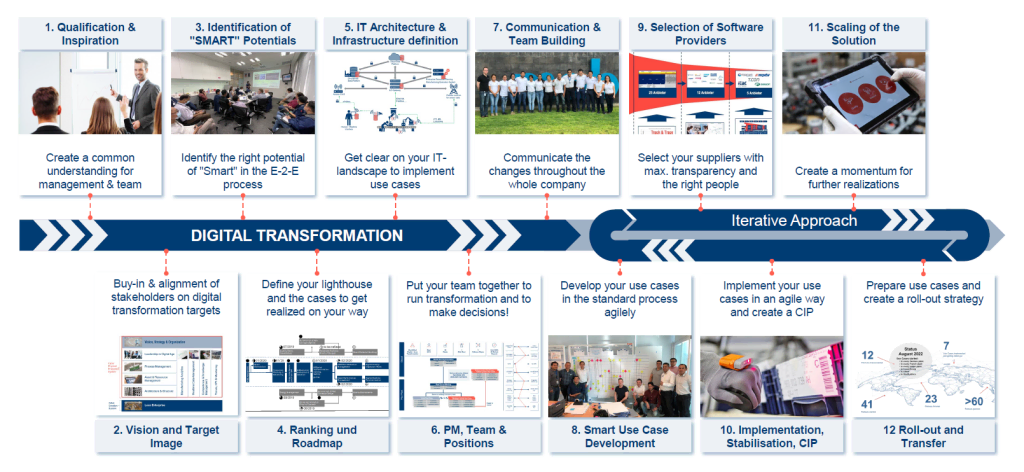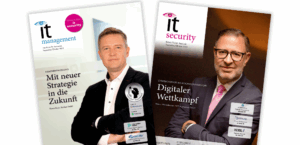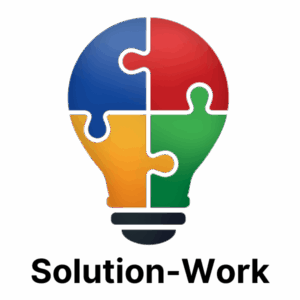Conflicting goals arise between IT and operations during the digital transformation: While operations want to implement suitable solutions quickly, IT departments are more concerned with security and fit with the existing IT architecture. This article presents five tips for finding a solution.
A digital transformation of operations is essential for industrial companies in order to ensure their competitiveness and future viability in an increasingly challenging business environment. However, this transformation presents companies with numerous challenges. One of these challenges typically concerns collaboration between IT and operations departments, as conflicts of objectives can quickly arise here.
While operations want to establish process-effective solutions as quickly as possible, IT departments consider data security, integrity and objectives from the perspective of holistic enterprise architecture management. In addition, there are challenges such as evolved system and infrastructure landscapes with limited flexibility and high maintenance costs, as well as isolated data silos with limited accessibility and integration capability. Other common problems include historically evolved systems that differ around the world, whose maintenance depends on individuals and which make global collaboration difficult. To successfully overcome these challenges, CIOs need to work closely with operations managers. Five tips to improve this collaboration:
1. Promoting a regular exchange
It sounds almost banal, but an essential step is to promote communication and collaboration between IT and operations. CIOs should regularly meet with operations managers to better understand the specific challenges and goals that arise from operations. An important aspect of this is to understand the respective business cases of operations in order to identify potential returns and risks of new applications and to prioritize and align different objectives. In this way, a coherent strategy can be developed that takes into account both IT and operations requirements. This is particularly important as the operations area is driven by process improvements and business-oriented requirements, while CIOs focus primarily on efficiency in the operation and administration of systems as well as risk minimization and future-proofing the entire application landscape. An understanding of the functional and non-functional requirements of the other department is therefore crucial in order to find a common modus operandi.
2. Establishing a common language
The different perspectives and influences of the individual disciplines result in a different vocabulary, which quickly leads to inefficient communication and time-consuming detailed discussions in the day-to-day business of company-wide transformation programs. CIOs and operations managers should therefore take care to establish a common terminology that is spoken and understood by all employees. Ideally, this step should be initiated at the start of a transformation program in order to avoid misunderstandings in important fundamental discussions about vision and objectives. This can effectively avoid inefficient communication and inefficient detailed discussions – and significantly accelerate program implementation.
3. Joint development of the future IT architecture
Only if IT and operations managers develop the future IT architecture together can it meet the requirements of both departments. CIOs should therefore not only pay attention to their own standards and norms, but also consider the requirements of operations. A modern IT architecture should offer flexible and scalable solutions in order to quickly and easily map new functional requirements from operations and thus have a positive impact on the company’s results. This requires systems such as PLM, MES, IIoT and low-code platforms that are sensibly integrated into an IT landscape. A clear understanding of roles and responsibilities and a structured approach to system integration are crucial here. The use of best practices and proven methods can help to future-proof the application architecture while optimizing processes in a targeted manner.

4. Joint implementation of software selection processes
In order to achieve the optimum benefit for the company, CIOs must ensure that the software selection for operations applications is also carried out together with representatives from operations. The selected software must meet the functional requirements of operations as well as the technical standards and non-functional requirements of IT. This step is of central importance, as a system or application can only be accepted if important stakeholders from both areas, as well as key representatives of future users, are involved in the solution selection process. In addition to the trivial fact that software selection processes should be methodical and clearly structured, their central added value lies in their role as a period for joint decision-making by all those involved and a coordinated team recommendation for a jointly favored solution or a preferred provider. It is advisable to have such processes for extensive systems such as ERP, MES or PLM managed or moderated externally. This makes it possible to have differences and conflicts of interest, which occur again and again in such processes, moderated by external experts and to find a balance.
5. Support citizen developers
A final point for the successful support of operations in the digital transformation is the promotion of citizen development in a structured and administered form. From an operations perspective, it is always necessary to set up quick and simple applications in order to create transparency about processes, initiate workflows or carry out basic analyses, e.g. in quality processes. Today, this is usually done in an unstructured way using Excel, database tools or other self-programmed solutions that are not standardized and integrated into the application landscape. The better alternative is to provide an administered and secure platform for building applications according to the low-code / no-code paradigm. CIOs can thus enable employees to develop their own scalable applications without the need for lengthy IT approval processes. Low-code platforms such as Microsoft Power Apps, Tulip or Peakboard offer a very good basis for developing solutions for very specific operational challenges on a standardized code base and according to a defined style guide.
By working together between IT and Operations and implementing these five tips, CIOs can effectively support the digital transformation of Operations. By both departments working hand in hand, the benefits of digital transformation for the company are maximized and provide a solid foundation for further change. This creates future-proof solutions and takes both IT and Operations to the next level.













